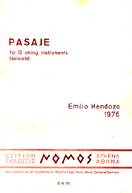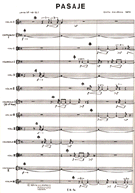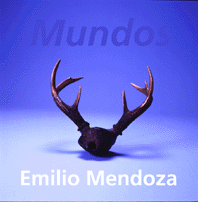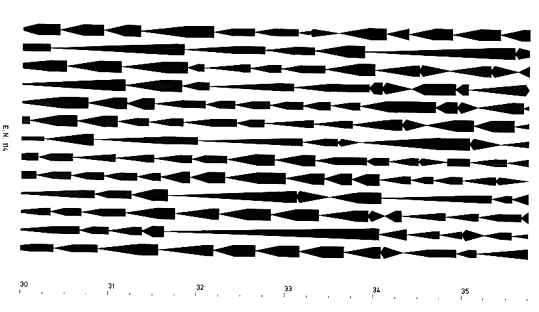



Partitura
PDF Versión
original en Edition Nomos, Athens, 1976,
SubVerlag Gerig, Cologne, después Breitkopf & Härtel,
Wiesbaden, ahora ArteMus, CA.
PDF Partitura nueva
transcrita
Distinciones

CD Mundos - Emilio
Mendoza Caracas: ArteMus, 1998.
Pasaje es un homenaje al Tiempo. La pieza
camina, oscila como un todo, y tiene también movimiento interno.
Se origina con sonidos muy cercanos al silencio, casi murmullos,
a través del arco friccionando la madera del puente de los
instrumentos. Nace proveniente de lo más distante desde las
sombras del fondo. El impulso del pensamiento interrumpe,
descoordinado al principio, y aparece el orden individual a
través de pulsos regulares y diferentes en cada instrumento.
Cuando nace el sonido continuo, como si brotara de un arroyo en
un muro de tierra, empieza la ondulación y el movimiento
interno. Un ejemplo de este recurso es el pasaje
de bandas de dinámica que se aprecia en el gráfico siguiente, en
los compases 30 al 35, de un lado al otro (arriba es el lado
derecho, abajo el lado izquierdo de la orquesta, el tiempo va de
izquierda a derecha):


Textos sobre la composición (1976):
La pieza se desarrolla en varias "dimensiones", como por
ejemplo el espacio real (izquierda - derecha), el espacio
psicológico de las alturas (alto - bajo), intensidad (piano
- forte), concentración o vacío de actividad, entre otras.
Siempre hay un incesante movimiento ondulante o pulsación en
una dimensión, o también en varias a la vez. Hasta cierto
punto, el uso de gráficos ayudó mucho en el proceso
compositivo como una manera de ajustar con más precisión lo
que se tenía pensado lograr, y para ayudar a conseguir la
textura en mente. Con este material, traté de construir un
pensamiento musical con una textura característica. La idea
general fue el transcurso de algo frente a un observador
estático. Esto es una característica propia de la música por
su acontecer en el tiempo, donde los sonidos pasan frente a
la memoria del oyente estático o viajando en su mismo
tiempo.
En este sentido es equiparable, aunque al revés, a las
obras cinéticas de nuestros autores plásticos, en las que la
vibración y vida de las obras sólo son conseguidas cuando el
observador se desplaza frente a ellas. He encontrado estas
obras de arte venezolanas (Otero, Soto, Cruz-Diez), ser muy
musicales en general, y una semejanza con mi pieza respecto
a la apariencia de sus texturas no es casual. El pasaje del
tiempo envuelve totalmente la percepción del ser humano
desde el transcurso de la vida, tanto a nivel biológico como
a nivel personal de días rutinarios, hasta el correr de la
historia frente al ser global, con sus ciclos repetitivos,
homogéneos pero diferentes en sus detalles. Nacido en
movimiento, el ser humano se encuentra dando vueltas y
ondulando en su órbita, y no le queda más por hacer que
seguir viviendo, sin fin ni meta, andando en su pasaje, en
su propio tiempo, en su vida.
La pieza está dedicada al antiguo pueblo Maya, por su
gran sentido y filosofía del tiempo. Su nombre en esbozo se
denominó "La Órbita Humana". Se inició su composición a
principios de 1976, aún en Venezuela y se culminó en
Düsseldorf, en el apartamento de Tannenhofweg, donde se
residenciaba con Alfredo Rugeles hasta 1977.
Texts about the composition (1976):
The general idea is the passing of something in front
of a static object. I think this is a characteristic
inherent to music for its occurrence in time, where the
sounds pass in front of the static listener's memory. The
same seems to happen, although in reverse, in the works of
the kinetic artists such as Alejandro Otero, Jesus Soto and
Carlos Cruz-Diez. There, the work's life and glitter is only
perceived when the observer moves or passes by the
sculpture. I found these works particularly musical and a
resemblance to my piece concerning the appearance of their
texture is not accidental. The passage of time involves the
human being's perception totally –from the passing of life
in a biological sense and at the personal level of days of
endless routine, to the course of history in front of the
total human being with its repetitive cycle, identical but
always different in detail. Being born in movement, the
human being finds itself going round oscillating in an
orbit, and has no more to do but to live, with no end nor
goal, enduring the passage. This piece is dedicated to the
ancient Maya civilization for its great sense and philosophy
of time.
The louder crescendi move from left to right and left again, these being as well longer and sustained.Similarly but in contrary movement, there is a displacement of a quieter mass of crescendi of more activity (greater number of events in a determined time), from right to left and right again. This adds up to a great pulsating conglomerate. Graph Nº 2, which is simplified, shows the movement of the total orchestral pitch in the same bars. Although each player changes constantly the notes they play, all the instruments keep within the band shown in the graph. The total pitch of the orchestra moves upwards and downwards, and eventually rises. The smaller band of broken lines denotes the region of pitch where most of the instruments play. That is to say, that although the wide band is maintained throughout, there are more instruments playing (concentration) in the smaller band of contrary movement, producing an overall sense of pulsation.
Masses in movement are created by other means as for
example the different pulses (bars 42 -53) which bring put
different intensities of the unison where coincide or not
with each other. Here a group of faster pulses oscillates
too from right to left. More isolated examples could
be given, but it is not my intention to explain the work in
words. With this I hope to approximate the reader to an idea
of the material involved and the general texture of the
piece. It is not a scientific nor serial work and the graphs
were only used as a help to create the texture I had
imagined, and with them construct a musical discourse.